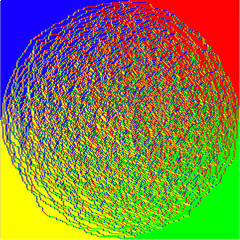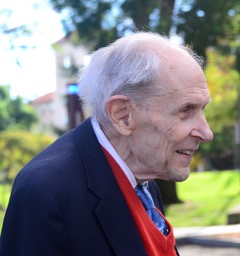The American Institute of Mathematics (AIM) is pleased to announce the first annual Alexanderson Award. The award is given in honor of Gerald Alexanderson, Professor of Mathematics at Santa Clara University and founding chair of AIM’s Board of Trustees. The Alexanderson Award recognizes outstanding research articles arising from AIM research activities that have been published within the past three years. Receiving the first award are Alexei Borodin, Ivan Corwin, and Patrik Ferrari for their article Free energy fluctuations for directed polymers in random media in 1+1 dimensions, Communications in Pure and Applied Mathematics, 67 (2014), 1129-1214. This work began during the October 2011 AIM workshop “The Kardar-Parisi-Zhang equation and universality class”.
The Award Winning Paper
One of the main goals in the study of probability is to understand the behavior of large, complex, random systems. At the coarsest level, this involves understanding the average or typical behavior of a system. That alone is often not enough and it is important to quantify how systems fluctuate or differ from their average. What are the extreme behaviors and how commonly do they occur?
Examples of systems where extreme events and random fluctuations are important to understand include the weather, cancer growth, and engineering processes where an extreme event can cause a catastrophe. The award winning paper concerns the extreme behavior of certain models for polymers—long chains of molecules that occur in nearly every manufactured product. If a polymer is dissolved in a solution, it forms a twisting, turning, thread that is unlikely to stretch out like a line, and which also is unlikely to curl into a tight ball. The typical behavior lies somewhere in between, like a loosely knotted floppy mound of string. Often times, the solution in which the polymers lie may be disordered, having random impurities or temperature variations that affect the overall probability of a given configuration. Directed polymers model such systems, when there is some external force pulling the polymer in a given direction.
The winning paper addresses the effect of the disorder on the configuration and energy of such polymers. The authors discovered that the behavior of such polymers is governed by a mathematical law that has been observed in several other situations. Mathematicians use the term “universal” to describe a rule that arises from seemingly unrelated phenomena. The most famous universal law is the “bell shaped curve” that governs the distribution of the heights of people, SAT scores, and the errors in scientific measurements.

Limiting fluctuations near the boundary of the random region of the tiling above satisfy the same universal law as the directed polymers.
The universal law arising in this work comes from the “Kardar-Parisi-Zhang equation” which models a variety of real world systems including growth processes (e.g., bacterial colony formation, cancer growth), development of cracks in materials, vortices in super-conductors, and movement of particles in random media. The statistical distributions (related to the “Tracy-Widom distributions”) studied in this paper in relation to these models have implications in physics, engineering, materials science, biology, ecology, and other applied fields. These distributions should be thought of as modern day equivalents to the bell curve (or Gaussian distribution). They are ubiquitous, cropping up all over science and mathematics.
Partial differential equations describe quantities (often indexed by time and space) that evolve as a function of their own values nearby, as well as possibly external data. As the world is inherently complex, such external data are often best approximated by random noise—hence the study of stochastic partial differential equations (equations that incorporate a random component). In non-linear systems (as opposed to linear), doubling an input does not double the output (for example, doubling a patient’s medication may more than double its effect). The Kardar-Parisi-Zhang equation is a very important example of a non-linear stochastic partial differential equation, and this paper offers major developments in methods to compute the statistical properties of the solution to this equation.
Through a mathematical device called the “Feynman-Kac representation”, the study of the Kardar-Parisi-Zhang equation is related to the study of directed polymers in random media. This is a special case of a more general study of polymers, which are chains of particles that configure themselves in an ambient space according to certain energetic considerations involving self-interaction as well as interactions with the media in which they lie. In this particle model, different paths in the plane are associated with different energies (related to the sum of the randomness along the path). The path then configures itself so as to balance its desire to minimize energy with the desire to explore lots of space. The nature of how such a path configures itself, as well as the total energy of a typical path, is directly related to the study in the paper.
View the award presentation and lecture
Gerald Alexanderson

A member of the Santa Clara faculty since 1958, Jerry has served his institution and the broader mathematics community in various capacities. During this time, he was chair of the Mathematics department for 35 years and a member of the Faculty Senate Council. For thirty eight years he held the endowed Valeriote Professorship of Science chair. Known as an inspiring teacher and popular author, Alexanderson has cultivated a passion for problem solving and has promoted creative mathematical thinking as longstanding Associate Director of the prestigious William Lowell Putnam Competition. He is author of more than a dozen books, including textbooks in abstract algebra, and discrete and combinatorial mathematics. Alexanderson was the first recipient of Santa Clara University’s Bayma Award for Scholarship, and he received the Special Appreciation Award from the Dean of Arts and Sciences as well as the Special Recognition Award for Teaching, Research, and Service from the President of the university.
Alexanderson’s influence has extended to the national level, where he has played a leading and lasting role in the Mathematical Association of America (MAA). His contributions to the MAA have spanned more than 50 committees and 24 years on the Board of Governors, encompassing secretary, vice-president, and president of the Association and editor of Mathematics Magazine. Results of this work include the remodeling of the MAA Carriage House in Washington, D.C., into its Mathematical Sciences Conference Center. In this time, Jerry served on the Science Policy Committee of the American Mathematical Society (AMS) and was a consultant to the Editorial Board for the Bulletin of the AMS. In testament to his expansive record, Alexanderson received the MAA’s most prestigious award for distinguished service to Mathematics, the Yueh-Gin Gung and Dr. Charles Y. Hu award.


